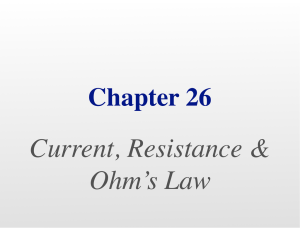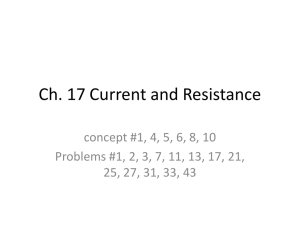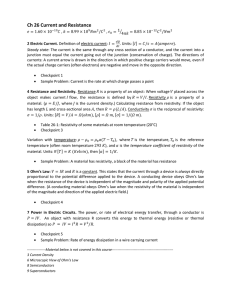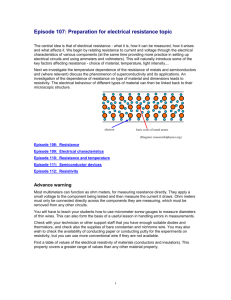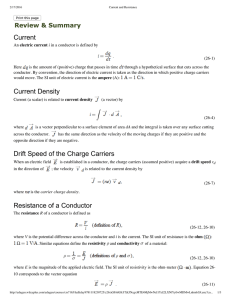summary_L06current_resistance_introduction
advertisement
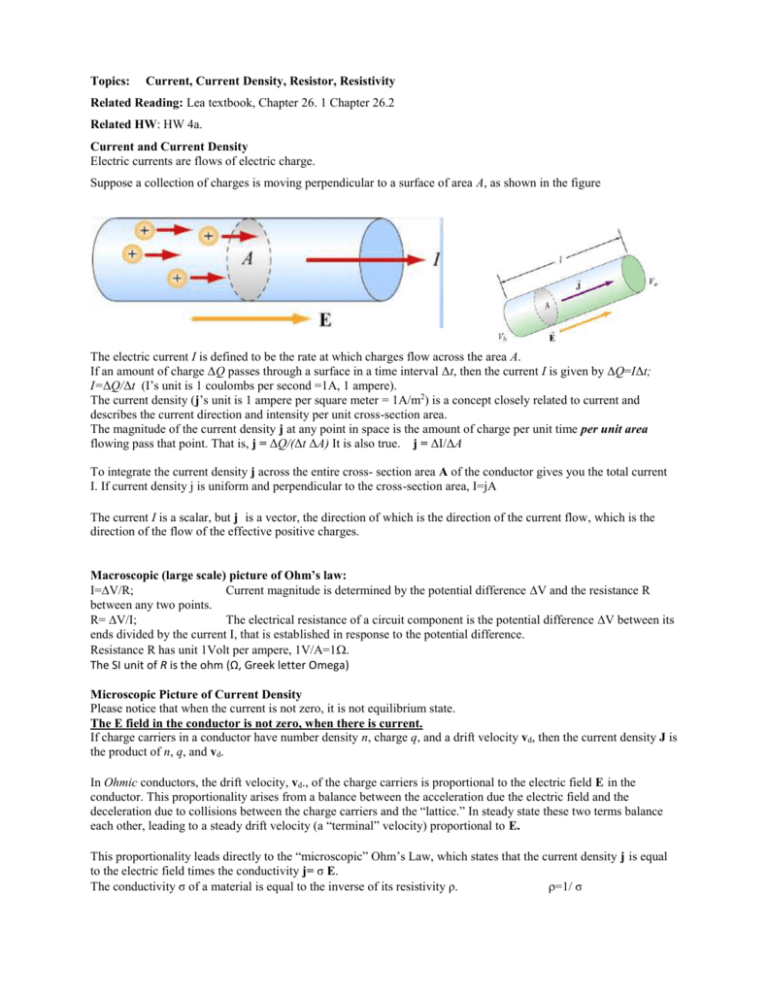
Topics: Current, Current Density, Resistor, Resistivity Related Reading: Lea textbook, Chapter 26. 1 Chapter 26.2 Related HW: HW 4a. Current and Current Density Electric currents are flows of electric charge. Suppose a collection of charges is moving perpendicular to a surface of area A, as shown in the figure The electric current I is defined to be the rate at which charges flow across the area A. If an amount of charge ΔQ passes through a surface in a time interval Δt, then the current I is given by ΔQ=IΔt; I=ΔQ/Δt (I’s unit is 1 coulombs per second =1A, 1 ampere). The current density (j’s unit is 1 ampere per square meter = 1A/m2) is a concept closely related to current and describes the current direction and intensity per unit cross-section area. The magnitude of the current density j at any point in space is the amount of charge per unit time per unit area flowing pass that point. That is, j = ΔQ/(Δt ΔA) It is also true. j = ΔI/ΔA To integrate the current density j across the entire cross- section area A of the conductor gives you the total current I. If current density j is uniform and perpendicular to the cross-section area, I=jA The current I is a scalar, but j is a vector, the direction of which is the direction of the current flow, which is the direction of the flow of the effective positive charges. Macroscopic (large scale) picture of Ohm’s law: I=V/R; Current magnitude is determined by the potential difference V and the resistance R between any two points. R= V/I; The electrical resistance of a circuit component is the potential difference V between its ends divided by the current I, that is established in response to the potential difference. Resistance R has unit 1Volt per ampere, 1V/A=1 The SI unit of R is the ohm (Ω, Greek letter Omega) Microscopic Picture of Current Density Please notice that when the current is not zero, it is not equilibrium state. The E field in the conductor is not zero, when there is current. If charge carriers in a conductor have number density n, charge q, and a drift velocity vd, then the current density J is the product of n, q, and vd. In Ohmic conductors, the drift velocity, vd., of the charge carriers is proportional to the electric field Ein the conductor. This proportionality arises from a balance between the acceleration due the electric field and the deceleration due to collisions between the charge carriers and the “lattice.” In steady state these two terms balance each other, leading to a steady drift velocity (a “terminal” velocity) proportional to E. This proportionality leads directly to the “microscopic” Ohm’s Law, which states that the current density jis equal to the electric field times the conductivity j= σ E. The conductivity σ of a material is equal to the inverse of its resistivity ρ. =1/ σ The resistivity of a material actually varies with temperature T. For metals, the resistivity is extremely low, because there are a lot of free charges. The resistivity linearly increases with increasing temperature over a large range of T: Because at higher T, the free charges will be blocked more by the active lattices of atoms. Semiconductors, such as silicon, have little free charges. When temperature is higher, more electrons can be set free, hence the conductivity increases and resistivity decreases. Please notice that resistivity ρ and conductivity σ describes the material’s properties in resisting and conducting current. They are microscopic properties determined by the atomic level facts of the materials. Resistivity ρ and conductivity σ are only related by the material itself and temperature. They are independent from the size and shape of the resistor. Just like the mass density of gold or silver depends on the material itself and temperature, but not related to the size and shape of the actual piece. On the other hand, resistance R is for a macroscopic circuit component (a resistor). R depends on the material’s properties (resistivity ρ) and the component’s length and cross-section area. R= ρL/A. R is proportional to material resistivity ρ and the length (the longer the channel is, the larger the resistance). R is reversely proportional to the cross-section area A. (the wider the channel is, the less the resistance). Power consumed in resistors when there is current: (Rate of Ohmic losses or Joule heating) This is precisely the power supplied by the battery.
